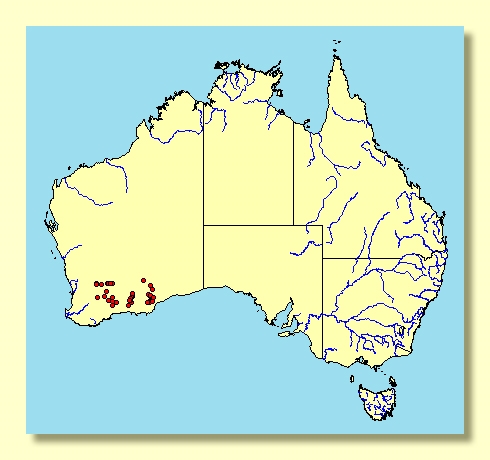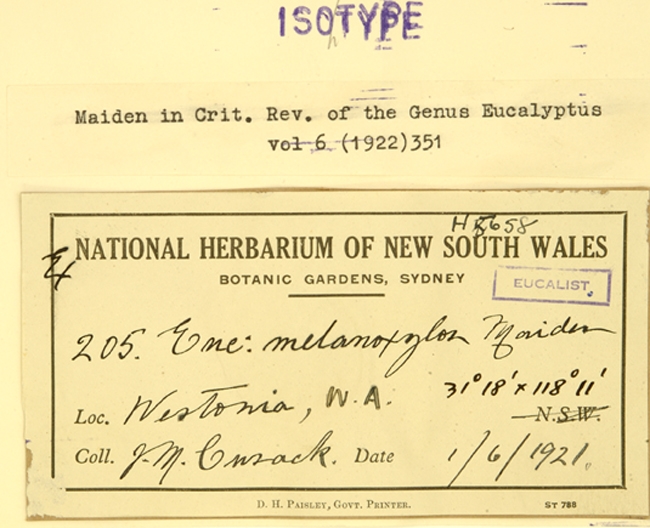Euclid - Online edition
Eucalyptus melanoxylon
Eucalyptus | Symphyomyrtus | Dumaria | Corrugatae
T: Westonia, W.A., 1 June 1921 & 15 Feb. 1922, W.M.Cusack 62 & 62K (published as J.M.Cusack); syn: NSW; isosyn: CANB, PERTH.
Bark rough to ca 4 cm diameter branches or sometimes only for half of trunk, fissured, thick, often spongy, dark grey to grey-brown or blackish, smooth above and white to grey-brown.
Branchlets have oil glands in the pith.
Juvenile growth (coppice or field seedlings to 50 cm): stems rounded in cross-section; juvenile leaves always petiolate, alternate, lanceolate, 4–7.5 cm long, 1.2–3 cm wide, dull, green to grey-green.
Adult leaves alternate, petioles 0.7–1.5(2) cm long; blade linear to narrowly lanceolate, 7.2–11(14) cm long, 0.7–1.2(1.7) cm wide, base tapering to petiole, margin entire, apex finely pointed, concolorous, glossy, green, side-veins acute, reticulation moderate to dense, intramarginal vein close to margin, oil glands island and intersectional.
Inflorescence axillary unbranched, peduncles 0.8–1.5(2.5) cm long, buds ?11 to 15, pedicellate, pedicels 0.3–0.5 cm long. Mature buds ovoid (0.5–0.8 cm long, 0.3–0.5 cm wide), scarcely ribbed, scar present, operculum bluntly conical to rounded (0.2–0.4 cm long), stamens inflexed, anthers oblong, versatile, dorsifixed, dehiscing by longitudinal slits, style long and straight, stigma tapered, locules 3 or 4, the placentae each with 4 vertical rows of ovules. Flowers white.
Fruit pedicellate, pedicels 0.2–0.4 cm long, obconical to cupular, 0.4–0.6 cm long, 0.5–0.6 cm wide, scarcely ribbed, disc descending obliquely, valves 3 or 4, exserted and spreading.
Seeds brown, 1–2 mm long, ovoid or flattened-ovoid, dorsal surface pitted, hilum ventral.
Cultivated seedlings (measured at node 10): cotyledons reniform; stems rounded in cross-section; leaves opposite for 3 or 4 nodes then alternate, narrowly ovate to lanceolate, 4–7.5 cm long, 1.2–2 cm wide, dull grey-green.
Flowering has been recorded in November.
A small to medium-sized tree, or sometimes a tall mallee, endemic to Western Australia, found in the eastern wheatbelt from Westonia, Kondinin and Lake King east to Salmon Gums and through the southern Goldfields to Balladonia and south to Breeboorinia Rock, on level to gently sloping sites with a variety of soils from clays to clay loams or sandy loams, usually with obvious limey component. The bark is dark, rough, box-type over most or all of the trunk, upper branches smooth, the adult leaves glossy green and fruit have valve tips exserted and slightly reflexed towards the rim.
Eucalyptus melanoxylon belongs in Eucalyptus subgenus Symphyomyrtus section Dumaria because the buds have two opercula, stamens are strongly inflexed, ovules are in 4 rows on the placentae and cotyledons are reniform. Within section Dumaria, E. melanoxylon and six other species - E. brachycalyx, E. concinna, E. corrugata, E. griffithsii, E. rugosa and E. laevis form a subgroup, series Corrugatae, all with ovoid, conspicuously pitted seeds and with dark brown oil glands in the pith of the branchlets.
E. melanoxylon is distinguished among the species forming series Corrugatae by the combination of tree habit, extensive rough bark, umbels of 11-15 more or less unribbed ovoid buds, and obconical fruit.
Superficially E. melanoxylon may be mistaken for E. oleosa or E. longicornis but if inspection of the branchlets reveals pith glands are present it cannot be either of these species.


















